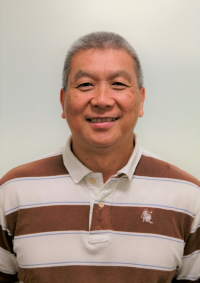Yew-Wah Liew1, Jin Ye Yeo2
1Red Cell Reference Laboratory, Australian Red Cross Lifeblood, Kelvin Grove, Queensland, Australia; 2AOB Editorial Office, AME Publishing Company
Correspondence to: Jin Ye Yeo. AOB Editorial Office, AME Publishing Company. Email: aob@amegroups.com
This interview can be cited as: Liew YW, Yeo JY. Meeting the Editorial Board Member of AOB: Dr. Yew-Wah Liew. Ann Blood. 2024. Available from: https://aob.amegroups.org/post/view/meeting-the-editorial-board-member-of-aob-dr-yew-wah-liew.
Expert introduction
Dr. Yew-Wah Liew (Figure 1) received his PhD from Portsmouth University, UK (formerly Polytechnic Institute). His PhD work focused on the use of lectins as reagents for blood group phenotyping. His PhD supervisor was Dr. GW Gregory Bird who was considered the "King of Lectins and Polyagglutination”.
Dr. Liew worked at the International Blood Group Reference Laboratory (when it was still based in London, then moved to Oxford, and now currently in Bristol, UK) from 1979-1990. In 1990, he moved to Australia and worked at the Australian Red Cross Lifeblood. While at the Blood Service, he occupied several scientific and management roles within the organization. Currently, he is manager of the Red Cell Reference Laboratory, Brisbane, Queensland.
Dr. Liew has published in several medical and Transfusion Medicine journals including Blood, Vox Sanguinis, Transfusion and British Journal of Haematology. He has been a subcommittee scientific member of the Australia and New Zealand Society of Blood Transfusion and helps organise the Queensland Immunohaematology Discussion Group – a local quarterly meeting for Medical Laboratory Scientists, Clinicians, and Researchers who have a keen interest in blood transfusion.

Figure 1 Dr. Yew-Wah Liew
Interview
AOB: What drove you into the field of blood research?
Dr. Liew: I was only taught the basic ABO and D groups back in university and when I started working in the field of blood groups, I found blood research so fascinating with so much unknown at that time.
AOB: As the subcommittee scientific member of the Australia and New Zealand Society of Blood Transfusion and the Queensland Immunohaematology Discussion Group, what are some areas of blood transfusion that are gaining attention? What are some goals that your team hope to achieve in the next few years?
Dr. Liew: Blood transfusion medicine is always revolving and changing with more sophisticated testing methods to help us, in particular molecular testing. In the next few years, we hope the testing will be even more efficient, accurate, and high through-put to allow this benefit to many patients.
AOB: Since the identification of the new blood group antigen JENU back in 2016 (1), have there been any significant discoveries in blood group genetics?
Dr. Liew: Not only JENU, but there have also been several new ones and it seems that new antigens and blood group systems are being discovered to add to the list every year, which currently stands at 47 blood group systems by the International Society of Blood Transfusion (ISBT) list.
AOB: Genomic sequencing combined with population studies has been helpful in identifying the cause of hemolytic disease of the fetus and newborn (HDFN). Could you share what are the biggest challenges in the identification of causes behind HDFN?
Dr Liew: HDFN is recognized and detected through antibody screening of the maternal sample and usually testing of the paternal sample will provide an answer. If it is a known antigen, then molecular testing is not necessary, but if it is unknown or rare, then gene sequencing will certainly help. The challenge is to be able to prove that the identified antigen is the actual cause of HDFN. Other affected siblings within that family and inheritance of the same antigen will certainly supports the findings.
AOB: How can the combination of genomic sequencing and population studies be further improved to manage HDFN?
Dr Liew: Firstly, once we identified the antigen involved, then population studies will aid in determining the frequency prevalence of that antigen. If it is very low, then it is a challenge to introduce it into a routine screening setting, but if it is of a higher prevalence, for example above 5%, then donor red cells with this antigen can be introduced into the screening of antenatal patient samples.
AOB: Do you have any advice for researchers who would like to venture into the field of blood research?
Dr. Liew: Research may not always yield results that you are hoping to find, but persistence is important and having good collaboration with other experts in the field will certainly help your goals. Attend many international conferences and make contact with experts.
AOB: How has your experience been as an Editorial Board Member of AOB?
Dr. Liew: I think I have not been too busy as a member, luckily, so I have enjoyed it.
AOB: As an Editorial Board Member, what are your expectations for AOB?
Dr. Liew: Hopefully more and more different fields of research papers continue to be published in the AOB.
Reference
- Lopez GH, Wilson B, Liew YW, et al. An alloantibody in a homozygous GYP*Mur individual defines JENU (MNS49), a new high-frequency antigen on glycophorin B. Transfusion. 2017;57(3):716-717. doi:10.1111/trf.13952
